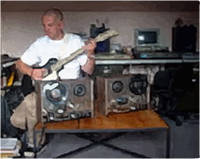S&S-->part 2
| 3Signs & Symptoms 
a young person's guide to Frippertronics
|
'Signs & Symptoms' is a series of extracts from low-speed reel-to-reel
stereo tape recordings made in the summer of 1980 in Amsterdam by
Peter Mertens and Harold Schellinx, inspired by the recording technique
- more than by its results - known as 'Frippertronics' (called that
way by guitarist Robert Fripp in the context of a series of solo
concerts in the late seventees, early eighties): a delay/feedback
system using two reel-to-reel audio-tape machines. I guess it doesn't make a lot of sense to point out some one, or even some group of individuals, as the 'originator(s)' of the idea to 'echo' back and forth between recording and playback heads ... it's pretty much something that came along with the machine. The 'Frippertronics' technique was used in Three Loops for Performers and Tape Recorders, which was Tony Conrad's first composition to be played in concert. In December 1961 each of the piece's three sections appears to have ended in a 'cacophonic feedback' which, however, as Conrad remarks in the appendix to his score, "provides an intrinsic part of the performance, and need not be deplored". The same appendix contains a diagram of the tape recorder set up, and a description of how the tape 'live looping' works: "[T]wo tape recorders are used, arranged so that one plays what has been recorded some interval of time previously by the other ([...]the 'tape loop length'); the other also records all that is played by the former. Thus sound events occurring at intervals equal to the tape loop length are superimposed [...]". 
Other early applications in music of the two machine 'Frippertronics'
set up originate in the San Francisco Tape Music Center (SFTMC), founded
in 1960 by Ramon Sender and Morton Subotnik, and during its first
seven years of existence directed by Pauline Oliveros. |
|
Nevertheless, it was due to Fripp and Eno's work that
the technique became popular, to a certain extent. Or let's
say: more widely known. And more widely used. Anyway. That's were
we got it from ... |
| top | S&S-->part 2
| 3
| ©harsmedia,
2002-2021